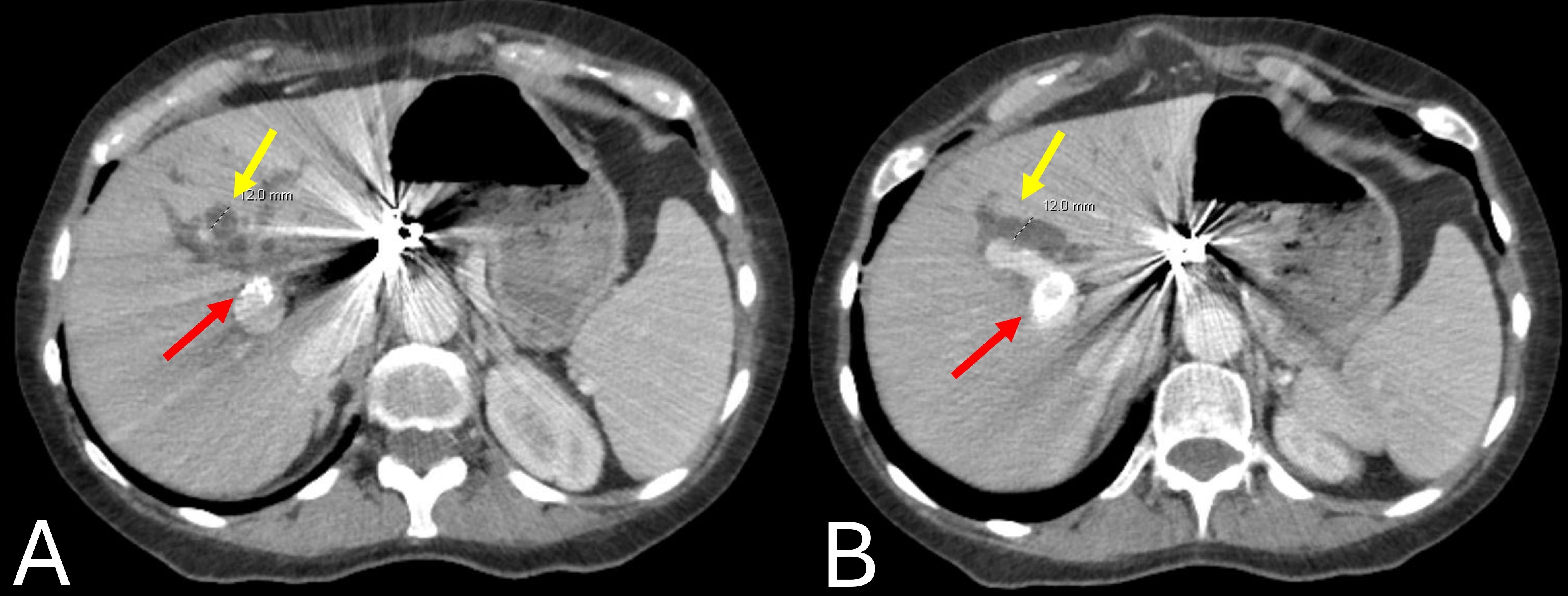Tuesday Poster Session
Category: Biliary/Pancreas
P4517 - Biliary Obstruction: A Rare Complication of Transjugular Intrahepatic Portosystemic Shunt
Tuesday, October 28, 2025
10:30 AM - 4:00 PM PDT
Location: Exhibit Hall

Giri Movva, MD
University of Texas Medical Branch
Galveston, TX
Presenting Author(s)
Giri Movva, MD, Amanda Warner, DO, Hari Movva, MD, Muhammad Mushtaq, DO, Mahnur Haider, MD, Ahmed S. Khan, MD, Sreeram Parupudi, MD
University of Texas Medical Branch, Galveston, TX
Introduction: Transjugular intrahepatic portosystemic shunt (TIPS) creates a channel between the hepatic and portal veins to reduce portal pressure and manage complications of portal hypertension. While effective, TIPS is associated with risks including infection, hepatic encephalopathy, and renal dysfunction. Biliary complications are rare, with biliary-venous fistulas being the most reported. Biliary obstruction due to stent-induced bile duct compression is exceedingly uncommon. We present a case of TIPS-related biliary obstruction.
Case Description/
Methods: A 62-year-old woman with autoimmune hepatitis-related cirrhosis, complicated by variceal bleeding treated with TIPS placement four months prior, presented with persistent vomiting, jaundice, and failure to thrive from gastroenterology clinic. On admission, she was hemodynamically stable. Labs revealed a total bilirubin of 14.5 mg/dL (previously normal), alkaline phosphatase 175 U/L, and mildly elevated aminotransferases. Computed tomography imaging showed new intrahepatic biliary dilation in the left hepatic lobe (Figure 1). Magnetic Resonance Cholangiopancreatography demonstrated moderate to severe left-sided biliary ductal dilation with an abrupt cutoff near the hepatic hilum adjacent to the TIPS. Endotherapy was not amenable due to the high-grade biliary obstruction, and attempts by interventional radiology to catheterize the common bile duct were unsuccessful. She underwent external percutaneous biliary drainage, later converted to an internal-external drain with improvement in symptoms. She was subsequently referred for liver transplantation upon discharge.
Discussion: Biliary obstruction due to TIPS placement is a rare but serious complication. Management can be challenging, as endoscopic drainage is often not feasible, necessitating percutaneous intervention. Definitive treatment typically involves liver transplantation or biliary-enteric anastomosis, as the TIPS cannot be removed. This case highlights the importance of early recognition and appropriate management of this uncommon complication, which can occur anytime from a few days to several years after TIPS placement.

Figure: Figure 1: A&B) CT Abdomen/Pelvis (Axial)- showing an intrahepatic biliary dilation in the left hepatic lobe (yellow arrow) and TIPS stent (red arrow).
Disclosures:
Giri Movva indicated no relevant financial relationships.
Amanda Warner indicated no relevant financial relationships.
Hari Movva indicated no relevant financial relationships.
Muhammad Mushtaq indicated no relevant financial relationships.
Mahnur Haider indicated no relevant financial relationships.
Ahmed Khan indicated no relevant financial relationships.
Sreeram Parupudi indicated no relevant financial relationships.
Giri Movva, MD, Amanda Warner, DO, Hari Movva, MD, Muhammad Mushtaq, DO, Mahnur Haider, MD, Ahmed S. Khan, MD, Sreeram Parupudi, MD. P4517 - Biliary Obstruction: A Rare Complication of Transjugular Intrahepatic Portosystemic Shunt, ACG 2025 Annual Scientific Meeting Abstracts. Phoenix, AZ: American College of Gastroenterology.
University of Texas Medical Branch, Galveston, TX
Introduction: Transjugular intrahepatic portosystemic shunt (TIPS) creates a channel between the hepatic and portal veins to reduce portal pressure and manage complications of portal hypertension. While effective, TIPS is associated with risks including infection, hepatic encephalopathy, and renal dysfunction. Biliary complications are rare, with biliary-venous fistulas being the most reported. Biliary obstruction due to stent-induced bile duct compression is exceedingly uncommon. We present a case of TIPS-related biliary obstruction.
Case Description/
Methods: A 62-year-old woman with autoimmune hepatitis-related cirrhosis, complicated by variceal bleeding treated with TIPS placement four months prior, presented with persistent vomiting, jaundice, and failure to thrive from gastroenterology clinic. On admission, she was hemodynamically stable. Labs revealed a total bilirubin of 14.5 mg/dL (previously normal), alkaline phosphatase 175 U/L, and mildly elevated aminotransferases. Computed tomography imaging showed new intrahepatic biliary dilation in the left hepatic lobe (Figure 1). Magnetic Resonance Cholangiopancreatography demonstrated moderate to severe left-sided biliary ductal dilation with an abrupt cutoff near the hepatic hilum adjacent to the TIPS. Endotherapy was not amenable due to the high-grade biliary obstruction, and attempts by interventional radiology to catheterize the common bile duct were unsuccessful. She underwent external percutaneous biliary drainage, later converted to an internal-external drain with improvement in symptoms. She was subsequently referred for liver transplantation upon discharge.
Discussion: Biliary obstruction due to TIPS placement is a rare but serious complication. Management can be challenging, as endoscopic drainage is often not feasible, necessitating percutaneous intervention. Definitive treatment typically involves liver transplantation or biliary-enteric anastomosis, as the TIPS cannot be removed. This case highlights the importance of early recognition and appropriate management of this uncommon complication, which can occur anytime from a few days to several years after TIPS placement.

Figure: Figure 1: A&B) CT Abdomen/Pelvis (Axial)- showing an intrahepatic biliary dilation in the left hepatic lobe (yellow arrow) and TIPS stent (red arrow).
Disclosures:
Giri Movva indicated no relevant financial relationships.
Amanda Warner indicated no relevant financial relationships.
Hari Movva indicated no relevant financial relationships.
Muhammad Mushtaq indicated no relevant financial relationships.
Mahnur Haider indicated no relevant financial relationships.
Ahmed Khan indicated no relevant financial relationships.
Sreeram Parupudi indicated no relevant financial relationships.
Giri Movva, MD, Amanda Warner, DO, Hari Movva, MD, Muhammad Mushtaq, DO, Mahnur Haider, MD, Ahmed S. Khan, MD, Sreeram Parupudi, MD. P4517 - Biliary Obstruction: A Rare Complication of Transjugular Intrahepatic Portosystemic Shunt, ACG 2025 Annual Scientific Meeting Abstracts. Phoenix, AZ: American College of Gastroenterology.
